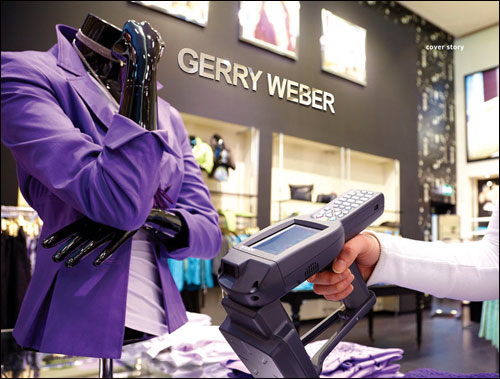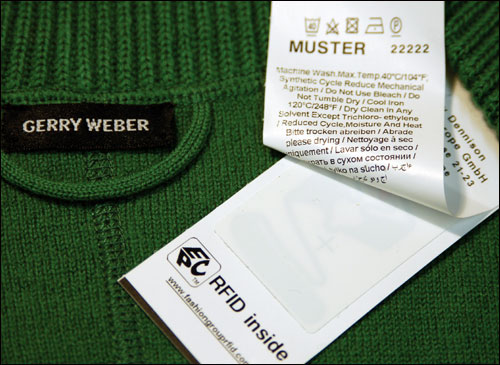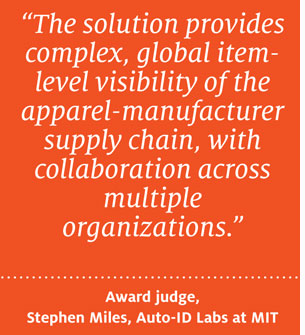Jun 01, 2011Change is tough, and Gerry Weber International, a German-based women's clothing designer and retailer, had big changes in mind—using radio frequency identification technology to track items throughout its supply chain and in its retail stores. The idea was to incorporate RFID tags with electronic article surveillance (EAS) functionality for loss prevention into each garment's product-care label. So when the company set out on its ambitious plan, it adopted a conservative strategy. "We revolutionize business processes where it doesn't hurt," says Gerry Weber CIO Christian von Grone.
Gerry Weber's philosophy dates back to summer 2009, when the company first piloted RFID technology in four stores. von Grone says that's when he discovered that to many store employees, "RFID is voodoo." The company decided to minimize confusion regarding RFID by leaving some of its most important processes—including checkout—unchanged. Similarly, the implementation of RFID at the point of manufacture didn't require suppliers to adjust any of their procedures.
Marrying its ambitious RFID plans with a managed approach has allowed Gerry Weber to realize its goals. Today, the company is RFID-tracking approximately 20 percent of the 25 million items it produces annually, under brand names including Gerry Weber, Gerry Weber Edition and G.W., as well as Samoon and Taifun by Gerry Weber. This involves working with some 240 outsourced manufacturing partners in China, Turkey and other countries, as well as the company-owned plant in Romania, a handful of third-party transport and warehouse logistics partners, and roughly 200 House of Gerry Weber stores in Germany.
The Revolution Begins
While change starts at the point of manufacture, don't ask the suppliers about it. Gerry Weber orders RFID-EAS labels from Avery Dennison, which has worldwide printing facilities, at the same time it places an order with a supplier. Avery Dennison transmits the order, which includes an XML file dictating garment care data and assigned Electronic Product Code numbers, to the printing center nearest to the manufacturing site. There, the labels are printed and the EPCs are programmed. Avery Dennison delivers the RFID-EAS care labels to the suppliers' doorsteps, and the workers follow standard procedures for sewing the labels onto items or attaching them to hangtags.
"There's nothing installed on the manufacturing site," von Grone says. "There are no extra steps in the process, and it's not more expensive for them to manufacture the garments than before." As a result, Gerry Weber was able to roll out RFID to all its manufacturers in just three months.
Where the company needed to adapt processes to benefit from RFID, it did. Now, the designer/retailer acts on information that comes from its third-party logistics providers, DHL Solutions and Hellmann Worldwide Logistics, which pick up the orders from the manufacturers. Both logistics firms have installed tunnel readers in their Far East warehouses; the interrogators read the RFID tags on garments, which are packed in boxes, before each shipment leaves the warehouse. The EPC numbers from each box are transmitted automatically to Gerry Weber's supply-chain management system, so any concerns can be addressed immediately. "If 500 items are missing, we can call the supplier and ask if there's a second shipment coming or find out what is the matter with the delivery," von Grone says.
When a shipment arrives at a Meyer & Meyer warehouse, RFID readers check that the EPCs match the delivery information from the supply-chain management system. Boxes go to one warehouse, hanging garments to another. The contents are placed on an automatic sorter, which reads their bar codes and places the items at drop-off points. RFID readers ensure the sort was done correctly before goods are stored.

Before apparel leaves the warehouse, an RFID-enabled check, which has replaced a manual verification count, sends the EPCs to the delivery database and affiliates the information with a serial shipping container code sticker that goes on the box. Fiege follows a similar process at its warehouse.
Automating warehouse logistics processes reduces labor costs and increases accuracy, which improves customer satisfaction. It's now readily apparent if an item is missing from a shipment, and it's easier to locate it in the warehouse. With roughly 80 percent of Gerry Weber's clothing sold in other retail outlets, this adds up to "less returns or less credit notes to customers because of missing or excess items," von Grone says. Gerry Weber says these improvements represent almost 30 percent of the RFID project benefits.
Stores Enlist
When goods arrive at Gerry Weber stores, workers use mobile readers to check incoming EPC numbers against advance shipping notices, while the goods are still in closed boxes or hanging unopened in plastic bags. "I know from all the EPCs that the goods are in," von Grone says. "If I am missing items or have excessive items, I can do a check with the database and see these were supposed to be at another store. I can make the transit from one store to the other, so we have correct inventory on both sides."
One of the main goals of the RFID deployment was to improve inventory management, a manual process that was too time-consuming to be conducted more than once a year, and often produced inaccurate results. Today, stores take inventory once a week; workers require roughly 30 minutes to do a full check of goods on the floor and in stock. "This is the biggest benefit driver, because we calculate about 7.5 percent more turnover on those articles that can be replenished, which gives us 2 to 3 percent more turnover on the store level," von Grone says. That high turnover means being able to sell items at full price, rather than marking them down just to get them off the floor. Gerry Weber expects this will account for nearly half the benefit of the RFID deployment, though verification depends on reaching the point at which all items on the floor are RFID-tagged.
Since the RFID tags have built-in EAS, the company's logistics providers no longer need to attach hard plastic EAS tags to garments to deter theft. "That is an immediate saving and a hard calculation—about 35 cents Euro [51 cents U.S.] per item," von Grone says.

As a customer leaves the store, a RAKO HoverGuard EAS reader antenna reads the EPC tag on the purchased item and requests information from the database about whether the item has been recorded as sold—if the merchandise appears to be in stock, the system triggers an alarm. If a customer is wearing a previously purchased Gerry Weber item from which she never removed the tag, the system won't recognize the EPC and won't send an alert. "That secures us against false alarms," von Grone states. "The system says, 'this EPC is not mine so I don't raise the alarm.'"
Gerry Weber customers are well aware their garments have RFID tags. In Germany, privacy guidelines are strict. Stickers at store entrances indicate RFID's use, as recommended by the European Union Commission. Customers are advised to cut the RFID portions of tags out before wearing clothing; the tags are placed so removal won't interfere with care instructions.
From Revolution to Evolution
Things went pretty smoothly for the €2.7 million ($3.9 million) project, but there were some challenges. One thing von Grone hadn't expected was that commitments to garment materials—say, 100 percent cotton—had to be made earlier in the cycle, to get the information into the database, so the care labels could be printed with RFID tags. Also, during installation of the EAS reader antennas at store entrances, the RFID team had to work around fire-sprinkler systems and air-conditioning units, which weren't noted on architectural drawings, that could hamper installation or readings.
Gerry Weber expects to realize a return on its investment within two years, von Grone says, and the company has plans for further changes, including working with its retailer customers to garner more benefit from RFID. The company believes its standards-based approach to RFID deployments will deliver value all around. "We've had more retailers since January 2011 than over the whole last year ask what we do with RFID and if they can join us," von Grone says. "Our goal is to make our retailers successful. RFID can create opportunities for the retailer to replenish Gerry Weber clothing articles more quickly and avoid out-of-stock situations that dissatisfy customers. If the retailer sells more Gerry Weber clothes and earns more with us, he will buy more than he does with competitors."
To learn about this year's other winners, see 2011 RFID Journal Awards: Excellence in RFID.

